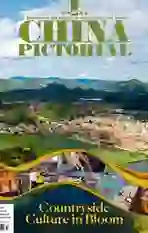Rural Revitalization Through Art
2022-04-29byQiaoXiaoguang
by Qiao Xiaoguang
Villages are evolving every day. A clear link between rural revitalization and national development has emerged over the past 40-plus years since Chinas reform and opening up. Rural revitalization through art is a rather complex and systematic endeavor, demanding respect for culture, region, ethnicity, and individual rights and interests.
Unlike art concepts and creation practiced mentally, the intellectual property involved in rural revitalization through art tends to be more prominent because business is involved. For this reason, a cooperative way is usually needed.
In Dali Dong Village, Rongjiang County, Guizhou Province, we found that the practice of the concept of rural revitalization through art has awakened and activated many local traditional handicrafts that were previously on the verge of extinction. Nowadays, ancient bridges in the village have become places to display and sell local handicrafts.
Rural revitalization through art requires two-way interaction between art and the countryside. Of course, there are frequently sharp differences between outside artists and local craftspeople.Taking the bags designed by professional artists and local women as examples: Professional designers engineered a unique and fashionable shoulder bag with colorful patterns, while local craftspeople produced bags mainly in black with supplementary green and decorative lacing to align with the inherent aesthetics of local clothing. Those bags of different styles reflect a dialogue between rural folk art traditions and trendy perceptions of professional designers, which involves no right-or-wrong judgment but only builds development based on inclusion and adaptation.
Obviously, achieving rural revitalization through art needs to cross many hidden barriers. The process cannot be smoothed via academic cognition consisting of knowledge systems and written texts alone; the soul of rural villages lives in everyday life and common sense. Each and every village or nation has a living philosophy; otherwise, they couldnt survive to this day. Similar wisdom can be found in the “philosophy of common sense” founded by Thomas Reid more than 200 years ago and Agnes Hellers “critical theory of everyday life.”
Instead of embracing projectbased efforts, rural revitalization through art should also move closer to everyday life, a common issue nowadays. The essence of folk art is for a survival purpose, not for arts sake or exhibition. The principle should be maintained for rural revitalization through art.
The theory of prototype enlightenment, a psychological concept, is appropriate in this context. For example, wherever they settle down, farmers still tend to build houses based on their original habits and aesthetics. Aesthetics and art are not fixed ideas, but reflect habitual thinking which quietly penetrates every aspect of life with powerful impressions and inertia. To revive rural areas through art, we must deal with myriad prototypes such as villages, indigo dyeing, and even cowsheds. Categorized as common sense in life, they contain knowledge about beliefs, facts, concepts, cultural heritage, and metacognition. Both in intangible cultural heritage protection and rural development, sociology has inspired mankind to focus on sustainable development rather than artistic creation.
A true picture of Zaidang Dong Village, also in Rongjiang County, as well as its future, is emerging when villagers greet visitors with a performance of folk songs. Their family bonds and original civilization are vividly reflected in the singing of local villagers. In this case, the entire village is like a classroom, its elders with a good command of endemic knowledge and secrets are the teachers, and its children are the most promising learners and inheritors. Museums house static history while villages embrace living civilization.

